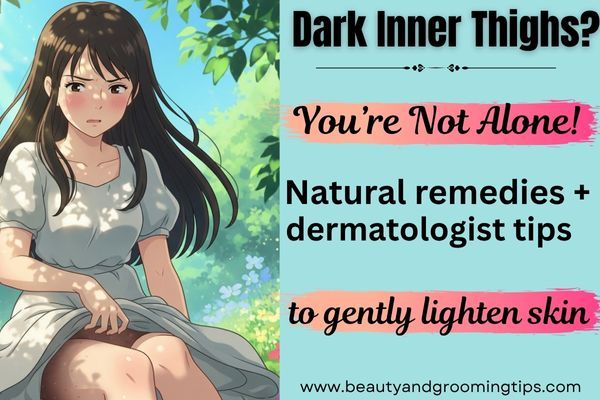Overweight, too less thigh-gap & sweat: If you are overweight or obese, there is a possibility that the gap between your thighs is very less. This will make the thighs to rub against each other while walking, not only causing discomfort to you, but the skin there may become reddish and sore.
Though this soreness may disappear after you apply an ointment, overtime such friction could lead to considerable skin darkening in that area.
If you have to walk too much and the thigh gap is almost negligible, your problem is still more aggravated. The constant friction between the fatty tissues will generate heat and of course you will sweat in those areas.
The chemicals in the sweat, the friction – all these will lead to skin discoloring. And in summer when the climate is extremely hot and humid, then this problem will inconvenience you to no ends.
Tight-clothing: Also if you are wearing tight clothing that clings to your body like second skin, you’ll have this problem. Wearing skin-tight jeans means these fabrics rub on your skin all the time making your skin several shades darker.
Hormonal issues: Certain hormonal changes, the meds you take (if you are on oral contraceptive pills), certain days in your menstrual cycle, if you have PCOS (Polycystic ovarian disease), insulin resistance etc. all these can cause significant skin darkening not only near the inner things but also at the back of the neck, underarms etc.
Medical Considerations
In rare cases, sudden or severe darkening (especially if paired with velvety texture or itching) could signal underlying conditions like acanthosis nigricans, often linked to insulin resistance or hormonal disorders. If home remedies show no improvement in 6–8 weeks, consult a dermatologist to rule out medical causes.
Shaving incorrectly: Excessive shaving with blunt blades and going over the same area again and again to get rid of the smallest hairs will not only irritate the delicate skin but also cause discoloration.
Home Remedies for skin darkening at the inner thighs
I’d like to suggest some home-remedies for your problem; they’ll not completely whiten the skin but definitely they will make the discoloration several shades lighter.· First of all, if you are overweight, try and reduce your weight. Cut down on your diet, exercise, do yoga and somehow lose weight. Your thigh gap will increase as a result and the friction will be less and you’ll also feel comfortable.
· Avoid tight-fitting clothes and change your undergarments twice a day.
· You may have found that the darkened inner thigh area is a bit drier than other areas. Apply coconut oil to which lemon juice is added. Coconut oil moisturizes and also helps do away with pigmentation and lemon juice is a bleaching agent. Apply it for about 20 minutes and then wash off with warm water.
· You mentioned that you tried to rub over the area vigorously. Don’t do that. Instead use a mild scrub like this one. Take some coarsely powdered oats, add some yoghurt and a tsp of honey; mix well and gently scrub over the area for 2 minutes. Leave it on for around 15 minutes and gently remove it off with a warm wash cloth. Oats and yogurt exfoliate the area, while honey is anti-bacterial, moisturizing as well as a bleaching agent.
· Application of sandalwood (chandan) or red sandalwood (rakta chandan) paste will also soothe the area. You may add a few drops of lemon juice to it also.
· Take milk powder, cucumber juice and honey and apply it to the affected area and leave on for 15 minutes. If you don’t have milk powder at home, you can substitute it with milk also.
· Break a vitamin E capsule into some aloe gel and apply to the area. Aloe is a natural skin soother and vitamin E will help with discoloration.
· You can also apply almond oil, coconut oil or olive oil to ease that area and reduce inflammation.
Prevention Boosters
- Beyond remedies, these habits help prevent further darkening:
- Opt for loose, breathable clothing (cotton/linen) to minimize friction.
- Apply a thin layer of coconut oil or anti-chafing balm before workouts/long walks.
- Stay hydrated and include vitamin C-rich foods (amla, oranges) to support skin healing.
Myths vs. Facts
Myth: Scrubbing harder or using bleach lightens inner thighs faster.Fact: Aggressive scrubbing damages the skin barrier, triggering inflammation and darker patches. Gentle exfoliation (2–3x/week) and moisturizing work better long-term
When to Seek Professional Help
If the darkening spreads rapidly, feels rough, or appears alongside other symptoms (like unexplained weight gain or fatigue), consult a doctor to check for hormonal imbalances (PCOS, thyroid issues) or allergies.Final Encouragement
Remember, slight skin tone variations are entirely normal—your worth isn’t defined by them! But if this bothers you, consistency with these remedies will help.
Share your experiences or questions in the comments below!


Comments
Post a Comment
Comments posted on this blog are moderated and approved only if they are relevant, on-topic and not abusive. Avoid using links to your site/blog in the body of your comment unless it is highly relevant to the post.